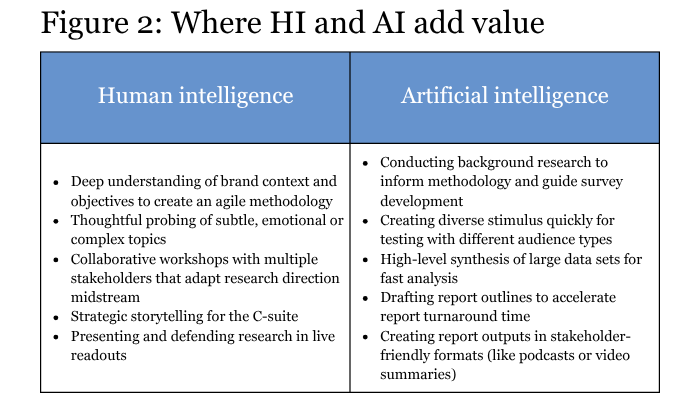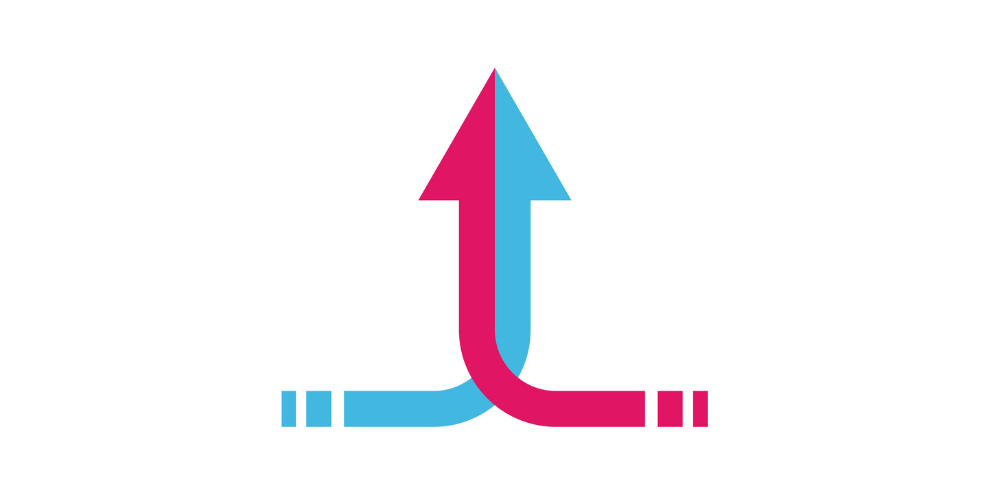Pairing AI with human intelligence to deliver research insights
Editor’s note: Laura Bayzle is managing partner at The Link Group.
When I first started in the industry 18 years ago, my boss and mentor taught me that research was a three-legged stool of price, speed and quality. Tinker with one leg, and the others must adjust – or the stool topples. If a client wanted high-quality research – a deep understanding of the customer’s voice and how decisions impact a brand – it would require time and money. If they needed fast, high-quality insights, it came with a hefty price tag. And if they wanted results both fast and cheap, it often meant sacrificing quality.
That adage no longer holds true. We’re at a point in our industry where clients need insights faster, cheaper and deeper.
And it’s understandable. Faster insights are crucial for clients to learn, adapt and stay ahead in a rapidly evolving market. But they also need those insights to be meaningful and accurate for better decision-making in this evolving market.
With AI, it feels like two legs of that stool are reinforced: price and speed. Traditional market research still offers richer insights, but it often requires more time and cost. So naturally, clients may ask themselves, “Are the insights from AI ‘good enough’ to move forward?”
In this brave new world, it can feel like artificial intelligence – with its ability to meet the faster, cheaper demands of our evolving industry – will win out over human intelligence.
But what if human intelligence and AI coexist? Rather than thinking of AI as artificial intelligence, what if we thought of AI as augmented intelligence? An exoskeleton for traditional research – one that allows us to be more agile without compromising deep, authentic and strategic insights.
Let me share an example of how we achieved this balance in a complex health care research project. By employing different techniques during research, we uncovered deep insights within a tight timeline – all while keeping human connection and intelligence at the core of the process.
Applying augmented intelligence to health care marketing research
A treatment without a target patient
Our client had developed a medication for a condition with limited treatment options and wanted to help health care providers (HCPs) better identify patients who could benefit. About 20% of patients with the condition were easy to identify: they openly discussed their symptoms and the impact of those symptoms on their lives, making diagnosis and prescribing straightforward. But the remaining 80% of patients? They either didn’t recognize their symptoms as part of a medical condition or didn’t bring them up at all. As a result, these patients often went unrecognized by HCPs and were undiagnosed and untreated. Our client had a great product, but they weren’t reaching a majority of the patient population.
The objective was clear: uncover subtle cues and nuances in patient-provider conversations. We needed to uncover details that went beyond the “obvious” patient. We anticipated it would be difficult for providers to recall specific dialogue, behaviors and critical details that would give us insight into how to identify these patients. We needed to really dig deep to deliver more authentic insights. And we needed results in a week.
HI + AI = richer insights, faster
At first blush, this timeline might suggest the research was better suited for synthetic respondents or an AI moderator. But we anticipated the conversations would require exploratory and nuanced probing. Deep, projective techniques and ethnographies would create better understanding, but we were time constrained. So, we found a middle path: using AI to augment our process, not replace it.
Bringing the patient to life with human and artificial intelligence
During the first two days of research (n=8 IDIs), we used real-time illustration. As providers described target patients, a live illustrator captured those descriptions visually, making subtle, abstract cues more tangible (Figure 1). By the end of those interviews, we had eight visual portraits of different patient types. In a client workshop, these images helped the team recognize shared descriptors, especially for the 80% of patients who weren’t “textbook.”

We then brought AI into the process. Using the HCPs’ descriptions, we created digital avatars: virtual patient personas we could modify and test. We developed patient “scripts” to explore what specific cues might prompt HCPs to recognize the condition and prescribe the treatment.
The workshop itself required human intelligence: researchers facilitated conversations, synthesized key findings and stakeholder perspectives, and kept the team grounded in the insights. We ensured all client and agency voices were heard and we helped the team align on a path forward. The human trust equity allowed the team to lean on us for our experience and for direction, which allowed us to move with agility.
With a narrowed set of avatar profiles, we returned to fieldwork (n=8 IDIs) to test the concepts we aligned upon in the workshop. HCPs interacted with these digital patients, diagnosing both on what they saw (how the patient presented physically) and what they heard (what the patient described). The team watched how the HCPs reacted to the patient cues in a real-world manner, leading to more authentic and deeper insights.
Because we used AI, we could tweak scripts or avatar characteristics in real time. A word change here, a new descriptor there – each adjustment took minutes, allowing us to iterate between interviews and deepen our understanding faster.
Using HI and AI to digest and socialize findings
At the end of each research day, we held debriefs with the team and used AI tools to analyze interview data quickly. This real-time synthesis allowed us to refine our discussion guides and adjust the next day’s session, which kept the project agile and sharp.
This agility extended to our reporting. Within hours of wrapping up the final IDI, we delivered actionable insights using technology-enabled formats, like a podcast report, so our clients could access research “on the go.”
The impact
The research led to a more precise description of the target patient in the sales detail, one that resonated with HCPs. They were able to recognize, diagnose and prescribe our client’s medication with confidence. After launch, sales reps reported that providers could immediately think of patients in their care who matched the profile. And prescription data supported that story. By anchoring the HCP in the lived experience of the patient – and using AI to augment the research experience and process – we helped drive real-world impact in a single week.
Using AI to enhance the impact of human researchers
This isn’t just a health care story. We’ve applied a similar HI + AI method across industries like CPG, financial services and tech. By continuously involving the client team, adapting dynamically to new insights and using innovative techniques, researchers can augment the research and achieve the right balance of speed, rich insights and low costs.
Of course, this approach isn’t without its limitations. It requires close client collaboration, agile decision-making and thoughtful integration of tools; not every project or project team is set up for that. This balance won’t look the same across all industries, budgets or timelines. But what’s important is that we experiment, iterate and stay open to ways AI can enhance the human core of what we do. What’s important is that HI is infused into any methodology that incorporates AI.

As market researchers, we are the gatekeepers when it comes to AI. I am not advocating that we bury our heads in the proverbial sand and ignore the AI revolution; rather, that we embrace AI in a way that enhances the value that we bring as human researchers. It’s up to us to set the tone and pace and demonstrate how both can – and must – coexist in order for accurate and authentic insights to keep pace with today’s fast-changing world.
